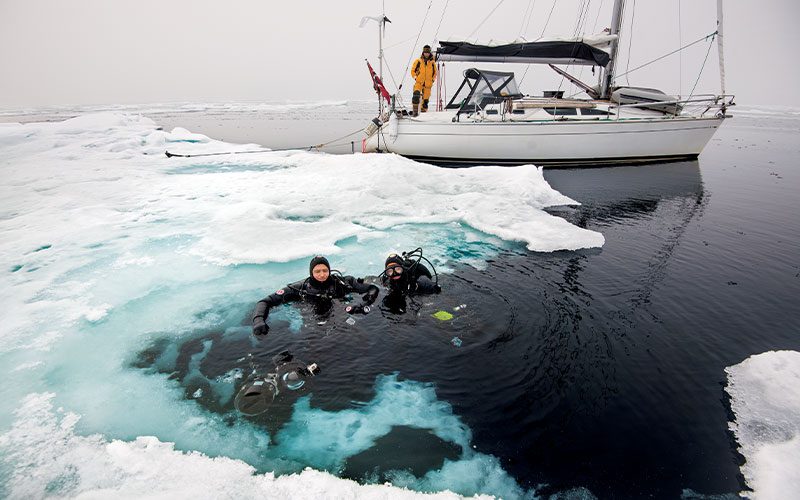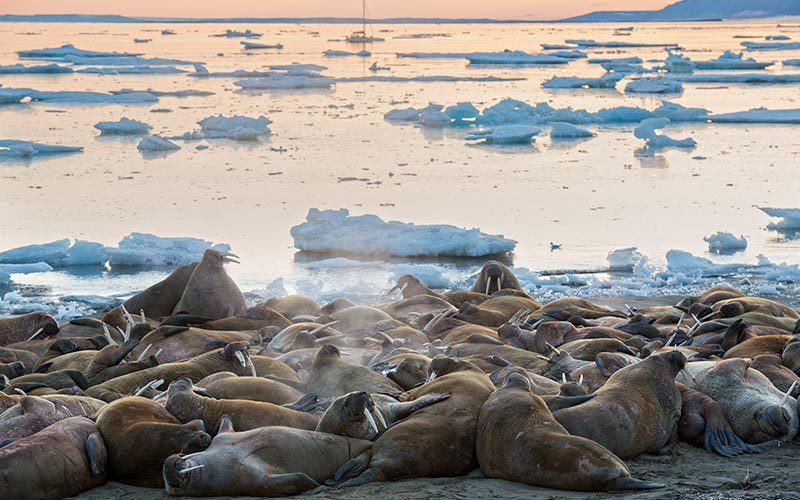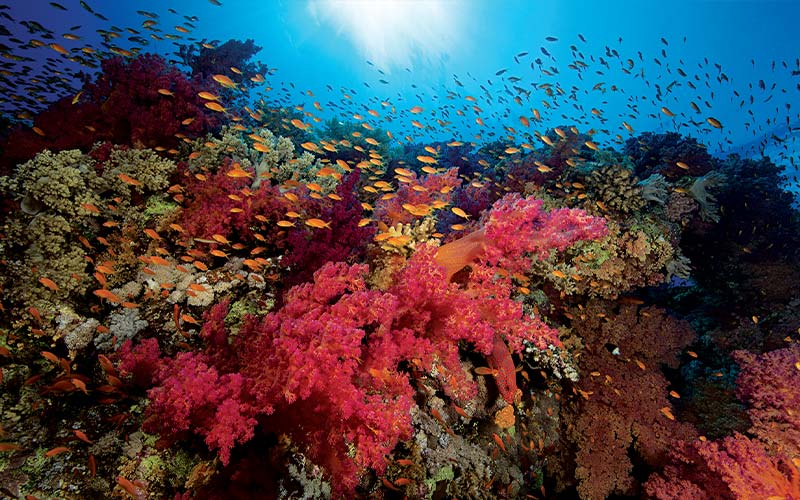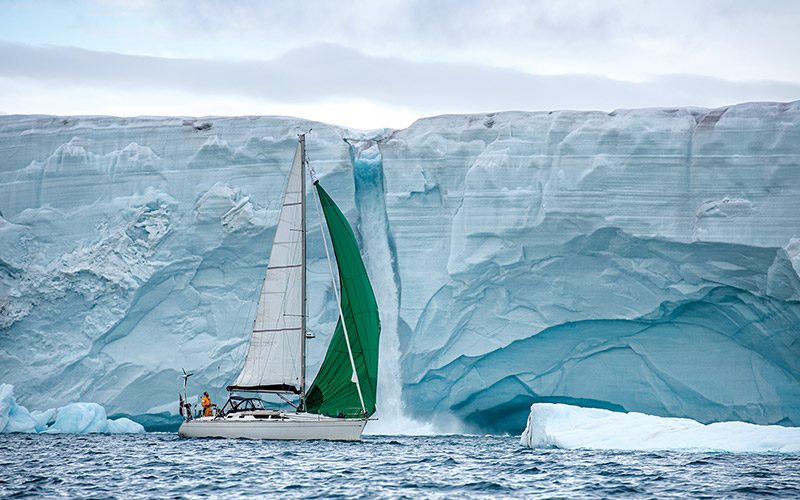Exactly what I did not want to happen has happened. I’m dangling upside down in murky marina water in Stavanger in southern Norway. The neoprene boots of my drysuit have ballooned with air, and the soles of my feet inside them are pointing skyward. It’s a classic conundrum for rookie drysuit divers.
Drysuit training is part of the preparations for an epic expedition we’ve planned to the Norwegian Arctic aboard Barba, a 37-foot sailboat. Our goal is to sail Barba all the way up Norway’s coast and then northward across the Norwegian Sea to Svalbard, an Arctic wilderness the size of West Virginia. Covered in glaciers, Svalbard is home to the densest population of polar bears on the planet.
After a few unsuccessful attempts to right myself, I give up and wait for my buddy. In a moment Andreas Heide, Barba‘s captain, fins up from below, grabs my harness and turns me upright.
Heide is no amateur. He started freediving at age 7 in the southern fjords of Norway. After getting his open-water certification at 17, he joined the Norwegian navy to become a combat diver. This is a guy who has bailed out of a submarine’s torpedo hold. But training me, a Florida-based dive writer accustomed to tropical waters and luxury liveaboards, is a whole new challenge.
After a few more practice sessions in the harbor and some tough love from Heide, I finally start to master my buoyancy. Then on the longest day of the year, the summer solstice, we set sail from Stavanger under a sun that barely dips below the horizon, with four months and 3,400 nautical miles of adventure ahead of us.
The Crew
Our five-person crew is a multinational, thrill-seeking bunch. First mate Jon Grantangen, a calm and cool Norwegian who has walked the entire length of Norway, has accompanied Heide on previous sailing expeditions to the Faroe Islands and the remote Arctic island of Jan Mayen. Daniel Hug, our German photographer, works as a geographer and avalanche observer in the Austrian Alps. He has brought along a paraglider, which he dreams of flying over polar bears once we get to Svalbard. Moscow-born Ivan Kutasov spent months sailing aboard a plywood boat to Novaya Zemlya in the Russian Arctic, where he once shimmied up a roof to escape a charging polar bear.
We’re sharing a small space, every inch of which is loaded with adventure gear — climbing harnesses, ice axes, paragliding equipment and, of course, dive gear.
Northward Along Norway
Our route will take us along the Norwegian mainland as far north as Tromsø, and from there we’ll make the roughly four-day crossing (about 600 nautical miles) to Svalbard. Once there, we hope the summer ice conditions will allow us to circumnavigate the archipelago, one of the Arctic’s wildest places. But first we have 900 nautical miles to travel along what has been called the most beautiful coastline in the world.
North of Bergen we stop at Store Batalden, a peak that rises 1,600 feet above an archipelago swirling with currents that promise abundant marine life. The calm harbor is a good place to practice diving from our small sailboat platform. We need to perfect our diving procedures for the remote regions of Svalbard, so we’ll squeeze in some training every chance we have along the Norwegian coast.

“The key words for the diving we’re doing are safety and simplicity,” Heide tells me as we gear up on the boat’s small deck, “Everything has to be optimized for ease of access since we’re bound to be in choppy seas.” We store our dive gear in two top-opening holds in Barba‘s cockpit. Our compressor is a gasoline-powered, German-made Bauer that can fill one of our 15-liter steel cylinders in about 30 minutes.
In addition to our drysuits (which would double as our survival suits in a worst-case scenario), we wear heavy neoprene boots and gloves and carry surface marker buoys as well as a McMurdo marine tracker that we can trigger if we lose sight of Barba. It sends a beacon with our location to the boat’s chart plotter so the crew will know where to find us.
We dive well within recreational limits and no more than twice a day, avoiding decompression obligations and always doing safety stops. When conditions warrant, we dive with a watertight drum, which is packed with flares and a hand-held VHF radio, trailing us on the surface. I ensured my DAN dive accident and travel insurance were current before I left Florida.
Getting separated from the boat is our biggest concern. “Even with a drysuit you have limited life expectancy in water this cold,” Heide reminds me. Along the coast of mainland Norway the water has yet to dip below 39°F, but it’ll get colder as we push north. And in Svalbard, even if we managed to swim to shore after a hypothetical separation from the boat, polar bears patrol the coast.
Norway’s landscapes constantly one-up each other as you travel north. Among the most memorable is the fairy-tale setting of Træna, a striking archipelago of more than 1,000 islands and islets on the Arctic Circle.
Three weeks after leaving Stavanger we arrive in Tromsø. There’s much work to be done to ready the boat for the four-day crossing to the southern tip of Svalbard, including provisioning for a 45-day stretch with minimal support, filling containers with extra diesel and raiding construction-site dumpsters for ice-pushing poles.

Arrival in Svalbard
Our crossing goes as smoothly as we could hope, and we spot our first iceberg — the size of a car — about 12 hours before we make landfall on Svalbard’s southern tip. The reality of where we are sinks in. Even a small bergy bit has the power to sink Barba if we hit it at cruising speed. Being on watch now requires constantly scanning the water for ice. By the time we enter Hornsund, Svalbard’s southernmost fjord, we are in the thick of it. The fjord is lined with glaciers, and their moans and groans fill the air as icebergs calve into the sea. We anchor and take a dinghy ashore, and there on the black-sand beach where we first set foot on land are fresh polar bear tracks.
All visitors to Svalbard who leave the town limits of Longyearbyen — Svalbard’s municipal capital, with a population of roughly 2,000 people and an airport — are required to carry a high-powered rifle and to know how to use it. The archipelago and the pack ice to the north are home to about 3,000 polar bears. Any time we venture ashore in Svalbard it’s with either Heide or Grantangen, our ex-military marksmen who carry rifles as well as flare guns for keeping curious bears at bay.
We spend a few days enjoying the creature comforts in Longyearbyen — bars, restaurants, shore power and fresh water in a terrific marina — before setting out on the toughest part of our expedition: circumnavigating Svalbard.
Finding True North
In addition to reindeer, polar bears, Arctic foxes and a host of seals, Svalbard has a population of about 2,000 walruses, which were hunted for nearly 350 years, almost to the point of extinction. We pass several sandy-beach walrus haulouts on our way north but decide to stick to observing the animals topside rather than risk tangling with them underwater, following the advice of a local wildlife filmmaker.
Walruses live primarily on shellfish, for which they forage on the seabed using their sensitive whiskers. They suck the meat straight from the shell and can eat thousands of clams during a single feeding session. The odd lone male has also been known to hunt seals, I learn. “They basically squeeze them to death and suck up their flesh,” the filmmaker in Longyearbyen told me. This is as good a reason as any to skip diving here and instead entertain ourselves with hiking, paragliding and enjoying beach campfires fueled by logs that floated to treeless Svalbard from Siberia.

One afternoon in Woodfjord, on the north side of Svalbard’s main island of Spitsbergen, we spot the telltale signs of exhaling cetaceans. We slip into our drysuits and attempt to snorkel with a pod of belugas swimming along the shore, but the animals are too quick for us. Their loud vocalizations (like bees buzzing combined with a finger circling the rim of a glass, as I’ve heard it described) fill the air topside and echo in our ears underwater.
We get in our first scuba dive at Depotodden on the island of Nordaustlandet on the west side of the archipelago, where we’ve anchored in front of a sheer mountainside the color of charcoal and streaked with snowy patches. Where there’s too much glacial runoff (about 60 percent of Svalbard is covered by glaciers), the water is too murky for diving to be worthwhile. But the beach at Depotodden is glacier-free, and the water under the boat looks clear and promising.
The stark scenery topside left us unprepared for the explosion of color that greets us beneath the surface. We don’t spot a single fish, but we scooter past bommie after bommie covered with orange and yellow anemones and crawling with crabs and sea slugs. When we surface, a walrus is swimming in the distance.
The next morning we get a wakeup call to remember. While struggling to raise a kelp-laden anchor, Heide spots a polar bear swimming straight for Barba and hustles below deck to grab his rifle and wake up the crew. Luckily our ice-pushing sticks are enough to keep the determined visitor from clambering into our dinghy. The look on the bear’s face is pure offense that we wouldn’t want him onboard as he tries again and again.
The 20 minutes we spend in such close proximity to the young male will surely go down as one of my life’s most memorable moments. The fact that we were diving in this water only hours earlier is not lost on us.
Into the Polar Ice Pack
We detour from our circumnavigation one day to sail northward to the polar ice. For many hours the sea is strangely ice free. And then suddenly floes begin to materialize around us. Small pieces give way to flat expanses the size of basketball courts and larger. Northern fulmars, the fighter jets of birds, carve turns above us, while ice floes bob slowly up and down on the glassy sea. Grantangen saw a polar bear on a distant ice floe, but we’ve lost sight of it now. We spot a seal asleep in the water nearby.

I look at Heide with a knowing glance. “Ready to dive?” I ask. If I’ve trained for anything, it’s the chance to see the underside of an ice floe where polar bears hunt. Grantangen stands watch on the stern, and we review our standard Svalbard diving procedure. He’ll toss a flare off the bow if he spots a bear and then will make sure it keeps its distance so we can surface safely.
My adrenaline is through the roof as we suit up on the ice and make a giant stride into the water. Clouds of tiny krill fill the 30°F crystal-clear water. There are no fish, just the odd tiny jellyfish with ruby-red tentacles. For 30 magical minutes as we make our way under and around the ice floe, our roof is an upside-down mountain range tinged glacier blue. We surface not to a bear but to our floating home, which has brought us all the way north to the polar pack ice — to the very edge of the world.

A few days later we sail south through the icy Hinlopen Strait. Along the Austfonna glacier, one of the largest ice caps in the world, we see more belugas beneath the waterfalls that gush over its edge. One day Heide and Hug soar with their paragliders over a cliff, where they are elated to spot a polar bear hunting below them.
In the end we manage to circumnavigate Svalbard. When we arrive back on the Norwegian mainland after a rough crossing, triumph trumps exhaustion.
All those frustrating upside-down moments training in Stavanger have been replaced with upside-down views of Arctic ice in one of the world’s last true wildernesses. Getting there was not easy, but the best things in life rarely are.
© Alert Diver — Q4 Fall 2015